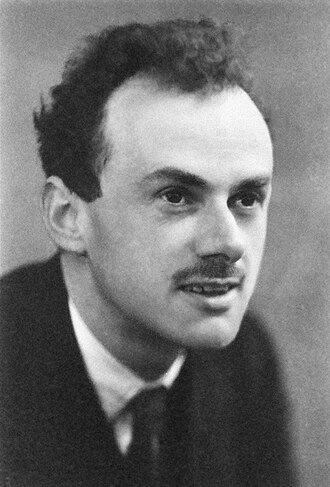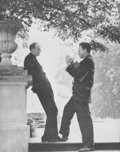Paul Dirac
Paul Adrien Maurice Dirac, OM (August 8, 1902 in Bristol – October 20, 1984 in Tallahassee) was an English physicist.
Paul Dirac | |
|---|---|
 Dirac, photographed in 1933 | |
| Born | Paul Adrien Maurice Dirac 8 August 1902 Bristol, England |
| Died | 20 October 1984 (aged 82) |
| Nationality | Swiss (1902–19) British (1919–84) |
| Alma mater | |
| Known for | |
| Awards |
|
| Scientific career | |
| Fields | Theoretical physics |
| Institutions | |
| Doctoral students | |
| Influences | John Stuart Mill[5][6] |
Dirac's father came from the French-speaking part of Switzerland.
Dirac worked out a formulation of quantum mechanics, which includes Erwin Schrödinger's wave mechanics and Werner Heisenberg's matrix mechanics in 1926. In 1928 he found the Dirac equation and he found out that spin in quantum mechanics is an effect of relativity. The Dirac equation allowed Dirac to predict the existence of antimatter, which is the opposite of matter.
In 1933 he won the Nobel Prize in Physics.
Dirac was the Lucasian Professor of Mathematics chair at Cambridge University from 1932 until his retirement in 1969. He was Professor of Physics at Florida State University from 1972 until his death in 1984.[7]
| Antimatter | |
| Overview | |
| Annihilation | |
| Devices | |
| Antiparticles | |
| Uses | |
| Bodies | |
People
|
Paul Dirac Media
Paul and Manci Dirac in Copenhagen, July 1963
Portrait of Paul Dirac by Clara Ewald, 1939
The 1927 Solvay Conference in Brussels, a gathering of the world's top physicists. Dirac is in the centre of the middle row, seated behind Albert Einstein.
Dirac (front row 3rd from left), next to Éamon de Valera (front row 4th from left), Erwin Schrödinger (front row 2nd from right) at Dublin Institute for Advanced Studies in 1942
The tombstone of Dirac and his wife in Roselawn Cemetery, Tallahassee, Florida. Their daughter Mary Elizabeth Dirac, who died 20 January 2007, is buried next to them.
The commemorative marker in Westminster Abbey
References
- ↑ "Nobel Bio". Nobelprize.org. Retrieved 27 January 2014.
- ↑ Bhabha, Homi Jehangir (1935). On cosmic radiation and the creation and annihilation of positrons and electrons. University of Cambridge. EThOS uk.bl.ethos.727546. https://www.repository.cam.ac.uk/handle/1810/250819.
- ↑ Paul Dirac at the Mathematics Genealogy Project
- ↑ Polkinghorne, John Charlton (1955). Contributions to quantum field theory. University of Cambridge. EThOS uk.bl.ethos.727138. http://idiscover.lib.cam.ac.uk/primo-explore/fulldisplay?docid=44CAM_ALMA21428195830003606&context=L&vid=44CAM_PROD&search_scope=SCOP_CAM_ALL&tab=cam_lib_coll&lang=en_US.
- ↑ Farmelo, Graham (2009). The Strangest Man: The Hidden Life of Paul Dirac, Quantum Genius. Faber and Faber. ISBN 978-0-571-22278-0.
- ↑ Cassidy, David C. (2010). "Graham Farmelo. The Strangest Man: The Hidden Life of Paul Dirac, Mystic of the Atom". Isis. University of Chicago Press. 101: 661. doi:10.1086/657209.
Farmelo also discusses, across several chapters, the influences of John Stuart Mill...
- ↑ "DigiTool Results Full". Retrieved January 30, 2012.[dead link]
Related pages
Other websites
| Wikimedia Commons has media related to Lua error in Module:Commons_link at line 62: attempt to index field 'wikibase' (a nil value).. |
- Dirac Medal Archived 2007-02-08 at the Wayback Machine of the International Centre for Theoretical Physics
- Dirac Medal of the World Association of Theoretically Oriented Chemists (WATOC)
- Photographs of Dirac Archived 2005-05-11 at the Wayback Machine
- The Paul Dirac Collection at Florida State University[dead link]
- The Paul A. M. Dirac Collection Finding Aid at Florida State University Archived 2007-04-02 at the Wayback Machine
- Photocopies of Dirac's papers from the Florida State University collection Archived 2009-11-16 at the Wayback Machine, held under Dirac's name in the Archive Centre of Churchill College, Cambridge, UK
- Letters from Dirac (1932-36) and other papers Archived 2009-11-16 at the Wayback Machine, held in the Personal Papers archives of St John's College, Cambridge, UK
- Annotated bibliography for Paul Dirac from the Alsos Digital Library for Nuclear Issues Archived 2019-05-02 at the Wayback Machine







